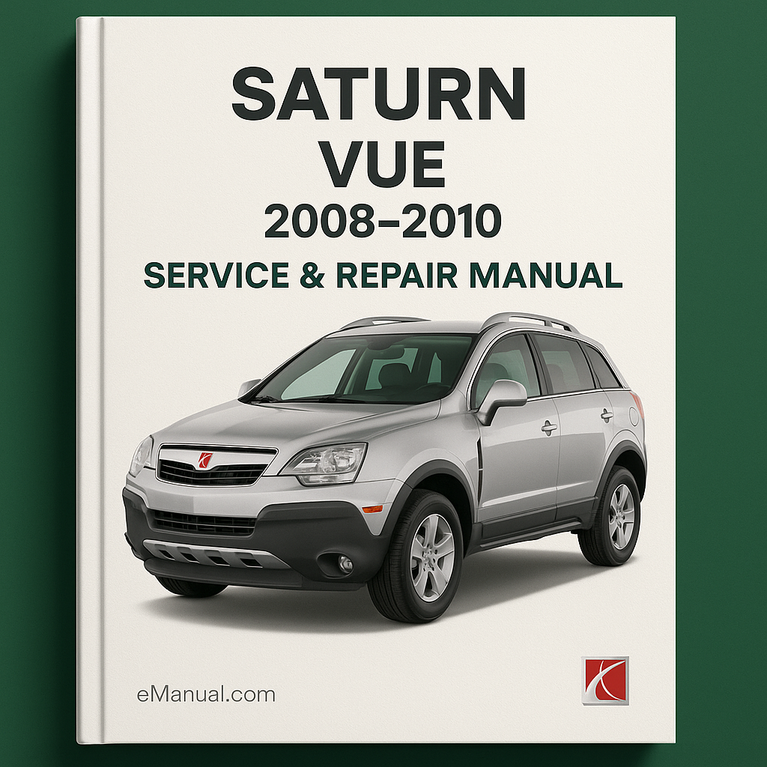Vehicle Segment:
Compact Crossover SUV
Brand Positioning:
Saturn was positioned as a value-oriented brand within GM, often focusing on unique styling and driver-centric features.
Competitors:
Honda CR-V, Toyota RAV4, Ford Escape, Chevrolet Equinox, Mazda CX-7.
Manual Advantage:
Provides dealer-level technical information, enabling significant cost savings on repairs and maintenance compared to dealership service.
Vehicle Appeal:
Known for its distinct styling, comfortable ride, and relatively spacious interior for its class.
Engine Mechanical:
Engine disassembly, repair, rebuild, component identification, timing systems, lubrication, cooling, and intake/exhaust systems.
Engine Performance:
Fuel system service, fuel specifications, emission control systems, ignition system diagnostics and repair, charging system.
Drivetrain:
Automatic transmission repair, manual transmission repair, clutch service, transfer case operation and repair, propeller shaft, drive shafts, differential service, and axle repair.
Suspension Steering:
Suspension system diagnosis and repair, shock absorbers, springs, control arms, steering column service, power steering system repair.
Brakes:
Brake control systems, brake component service (pads, rotors, calipers), parking brake system repair.
Electrical Electronics:
Complete electrical system diagnostics, troubleshooting, wiring diagrams, multiplex/CAN communication systems, ignition, starting, charging, instrument panel, audio/visual systems, horn, engine immobilizer, cruise control.
Comfort Convenience:
Air conditioning system service and repair, supplemental restraint system (SRS) diagnostics and repair, seat belt service, wiper and washer systems, door lock mechanisms, interior and exterior trim, seats, engine hood/doors.
Body Chassis:
Body and chassis repair, glass and mirror replacement, windshield service.
Maintenance:
Regular maintenance procedures, fluid changes, filter replacements, tune-ups.
Troubleshooting:
Diagnostic procedures for various systems, common problem identification and solutions.
Repair:
Step-by-step repair instructions for virtually all vehicle components, from minor adjustments to major component overhauls.
Diagnostics:
Detailed diagnostic procedures, including electrical system troubleshooting and wiring diagrams.
Depth:
High, comparable to dealer-level service manuals, with detailed substeps, notes, cautions, and warnings.
Visuals:
Hundreds of photos, illustrations, drawings, and enlarged inset views for clarity.
2008-2009 Base Engine:
2.4L Ecotec L4 (Naturally Aspirated)
2.4L Ecotec L4 Horsepower:
169 hp @ 6200 rpm
2.4L Ecotec L4 Torque:
155 lb-ft @ 4500 rpm
2008-2009 Optional Engine:
3.5L High Feature V6 LZ9 (Naturally Aspirated)
3.5L V6 Lz9 Horsepower:
224 hp @ 6200 rpm
3.5L V6 Lz9 Torque:
220 lb-ft @ 4800 rpm
2010 Primary Engine:
2.4L Ecotec LAF (Naturally Aspirated)
2.4L Ecotec Laf Horsepower:
174 hp @ 6500 rpm
2.4L Ecotec Laf Torque:
162 lb-ft @ 4700 rpm
2010 Optional Engine:
3.6L High Feature V6 LLM (Naturally Aspirated)
3.6L V6 Llm Horsepower:
252 hp @ 6300 rpm
3.6L V6 Llm Torque:
249 lb-ft @ 4700 rpm
Fuel Delivery:
Multi-port Fuel Injection (MPI)
Recommended Fuel:
87 Octane Unleaded Gasoline (Check manual for specific grade recommendations)
2.4L Engine:
5-Speed Manual Transmission (FWD)
3.5L/3.6L V6 Engine:
6-Speed Automatic Transmission (FWD or AWD)
2.4L Engine:
4-Speed Automatic Transmission (FWD or AWD)
Automatic Transmission Type:
GM Hydra-Matic (e.g., 4T45-E for 2.4L, 6T70 for V6 models)
AWD System:
Intelligent All-Wheel Drive system
Length:
Approx. 176.9 inches (4493 mm)
Width:
Approx. 71.1 inches (1806 mm)
Height:
Approx. 65.6 inches (1666 mm)
Wheelbase:
Approx. 103.4 inches (2626 mm)
Curb Weight Approx Min:
3,400 lbs (1542 kg) for FWD 2.4L models
Curb Weight Approx Max:
3,750 lbs (1701 kg) for AWD V6 models
NHTSA Front Crash Test Driver:
5-Star (for 2008 models)
NHTSA Front Crash Test Passenger:
5-Star (for 2008 models)
IIHS Side Impact Rating:
Good (for 2008 models equipped with side airbags)
ABS:
Standard Anti-lock Braking System (ABS)
Traction Control:
Available Traction Control System (TCS)
Electronic Stability Control:
Available StabiliTrak Electronic Stability Control
Airbags:
Standard front airbags, optional front side-impact airbags and roof rail airbags.
Audio System:
Available AM/FM/CD/MP3 players, some models with Bose premium audio systems.
Navigation:
Optional factory-installed GPS navigation system.
Cruise Control:
Standard cruise control, with steering wheel mounted controls on higher trims.
Auxiliary Input:
Standard auxiliary audio input jack on most models.
Bluetooth:
Available Bluetooth connectivity for hands-free calling and audio streaming on select models/trims.
Oil Change Interval:
Every 7,500 miles or 6 months (with synthetic oil), or 3,000 miles/3 months (with conventional oil, under severe conditions). Consult manual for exact recommendations.
Tire Rotation Interval:
Every 7,500 miles
Cabin Air Filter Replacement:
Every 15,000 miles or 12 months
Engine Air Filter Replacement:
Every 30,000 miles or as needed based on driving conditions
Spark Plug Replacement 2.4L:
Approx. 100,000 miles (Iridium-tipped)
Spark Plug Replacement V6:
Approx. 100,000 miles (Iridium-tipped)
Engine Oil Type 2.4L:
SAE 5W-30 Synthetic Blend or Full Synthetic (API certified)
Engine Oil Type V6:
SAE 5W-30 Synthetic Blend or Full Synthetic (API certified)
Coolant Type:
GM DEX-COOL® (Orange) Extended Life Antifreeze/Coolant
Transmission Fluid Automatic 4-Speed:
Dexron VI Automatic Transmission Fluid
Transmission Fluid Automatic 6-Speed:
Dexron VI Automatic Transmission Fluid
Power Steering Fluid:
GM Power Steering Fluid (or equivalent)
Brake Fluid:
DOT 3 or DOT 4 Brake Fluid
Engine Mounts:
Premature failure of engine mounts, especially on V6 models, can lead to excessive vibration.
Water Pump:
Leaking water pumps, particularly on the 3.5L V6, are a common concern.
Suspension Components:
Wear in suspension components like ball joints and control arm bushings can lead to clunking noises and poor handling.
Exhaust System:
Corrosion and failure of exhaust system components, especially in rust-prone climates.
Power Steering Pump:
Potential issues with the power steering pump and fluid leaks.
Saturn Introduction:
Saturn was launched by General Motors in 1985 as a distinct brand focused on innovative automotive design and customer satisfaction.
Vue Introduction:
The Saturn Vue was first introduced for the 2002 model year. The 2008-2010 models represent the second generation of the Saturn Vue, which debuted for 2008 with significant styling and mechanical updates.
Second Generation Updates:
Updated styling, new engine options (including V6 engines from GM's High Feature family), improved interior quality, and enhanced safety features.
Manufacturing Location:
Spring Hill, Tennessee, USA
Production End:
Saturn brand production ceased in 2010, impacting the final model year for the Vue.
